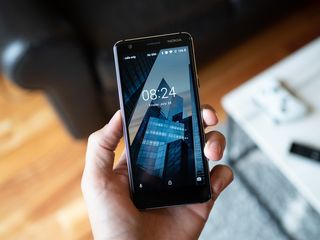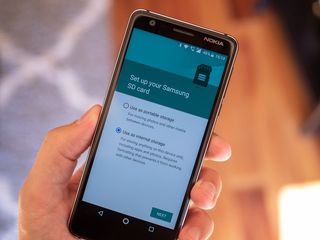Android Central Verdict
Price: $159Bottom line: For an affordable price, you can get a phone that gets all of the basics done pretty well. It has a good quality screen and nice hardware, and is a compact option among lots of big budget phones. Its slow performance and lack of a fingerprint sensor are disappointing, but you get good Android One software in return.
Pros
- +
Better-than-expected screen
- +
Solid materials and good styling
- +
Android One software
- +
Full-day battery life
- +
MicroSD slot for adoptable storage
Cons
- -
Slow performance
- -
2GB of RAM is disappointing
- -
No fingerprint sensor
- -
Micro-USB charging
Why you can trust Android Central
We often talk about "cheap" Android phones in reference to devices like the Moto G6, which typically cost about $225. But many people don't even want to break the $200 barrier when they're looking for a phone, whether it's because they just broke their flagship device and don't want to spend $800 again, or they simply don't want to budget out that much for a device in the first place.
For these people, the options are numerous — but they're all pretty bad. Down around $100, you're getting into the territory of horrible one-off prepaid phones with bad software, old specs and missing features. At best you're going to get an Android Go phone, like the Alcatel 1X, that at least has good software but is still horribly hamstrung by its internals. But sitting just a little bit higher, at $159, there's a cheap phone that still follows the recipe of a device that's more expensive: the new Nokia 3.1.

Small but strong
Nokia 3.1 What I like
The Nokia 3.1 is immediately appealing because of its hardware quality and size. The lightly grippy flat plastic back is handsome, and the curved glass on the front running into the sides is classy for a $159 phone. Getting a nicely coated metal frame is also treat, and it really gives the feeling of a phone that's built to sell for twice the price. Frankly the whole phone feels overbuilt for the money — I'm not sure how much it costs to make it this nicely, but Nokia could've easily skimped on the materials and build quality here and still been ahead of the competition's flimsy thin plastic phones.
Nokia's strength remains in its hardware, design and core features.
Unlike so many of the competitors in the segment that are trying to give you the largest screen for the money, the Nokia 3.1's 5.2-inch 18:9 display gives the phone a refreshingly "just right" size that's easy to handle. Even though the larger-than-usual bezels make it even taller than usual. The display itself is very good for a sub-$200 phone. 1440x720 resolution is more than enough for this size, and the viewing angles and brightness are actually above what I was expecting. The only two downsides are that it doesn't get particularly dim for late-night viewing, and curiously there's no night mode.





The rest of the hardware features round out well. A headphone jack is a welcomed sight, especially because it also enables a proper FM radio app on the phone. The speaker is also surprisingly loud — it doesn't sound good, but for podcasts and spoken word radio it gets the job done for short periods. If it's not going to offer a great sound experience, you might as well have it be loud enough to give you something to enjoy. The 3.1 also has an extremely strong Bluetooth connection over distance in through walls, in some cases better than my flagship phones. That's likely thanks to the plastic backing, but whatever the cause it's a surprise to experience in such a cheap phone (even though it's only Bluetooth 4.2).
I don't think any $159 phone deserves much mention of the camera performance so long as it works and is consistent. The Nokia 3.1's 13MP camera gets the job done with an incredibly simple interface. Like the Nokia 6.1 it's a bit slow to capture, but it's manageable in this case ... and you're more willing to give it a pass at this price. With HDR and a steady hand, the photos are colorful but struggle with dynamic range and crispness in details; the only big issue I found was with slow focus speeds that sometimes took a few attempts to lock on a subject. Aside from that, nothing big to report — just keep your expectations low here, especially in low light where the photos get very bad very quickly.











Android One is a nice experience at the low end, and the battery life is good.
Nokia made a decision to go all-in on Android One software, and the 3.1 is a perfect example of the type of phone that benefits from it. With extremely low-end specs, so many of these inexpensive phones are burdened with superfluous bloatware and extra features that they simply can't handle. That's not the case with the Nokia 3.1, because it's stripped down and simple just like every other Android One phone. The interface is clean and simple, and the Google apps shine here as they do on the Pixels. Android One should also give the Nokia 3.1 a better chance at future software updates, though at the time of writing it's stuck on Android 8.0 with the May 5 security patch — I wouldn't expect it to stay that way for long.
The simple software and relatively small display lead to really good battery life in my testing, even though I wasn't expecting it with the 2990mAh battery capacity. I had absolutely no issue going through a full day of use and ending with 20% battery, and the Nokia 3.1 is particularly stellar with standby battery life — if you're not using it, it's hardly draining. It's disappointing to be charging up over Micro-USB on a phone launched in mid-2018, but I understand that this is also what the competition is using still.

Performance in question
Nokia 3.1 What I don't like
The achilles' heel of the Nokia 3.1 experience is poor performance, which is brought on by a set of inferior specs across the board. An octa-core Mediatek MT6750 processor runs the show here, which is ostensibly comparable to the Snapdragon 425, and just isn't fully up to the task. Particularly because this U.S. Nokia 3.1 has just 2GB of RAM, which is incredibly tight for a phone in 2018 that has any thought of being smooth and quick to switch between apps. After the system takes its allocation, there's less than 1.8GB remaining — and somewhere around 400-500MB available during normal use. That can easily be chewed up by just a couple of apps, and you really notice when apps are dumped from memory during regular use.
The specs simply don't offer enough performance, particularly when multitasking.
Between the processor and limited RAM the Nokia 3.1 just isn't as smooth and consistent as I'd like. It's good enough. It's about average. But it definitely isn't smooth or what I'd consider quick. You notice the amount of time it takes to open apps, and you really notice the sluggishness when you're trying to multitask. Start listening to music or a podcast in the background while swapping between other apps, and you'll be waiting multiple seconds for each app to open in some cases. This phone really is only built for uni-tasking.
I'm cautiously optimistic that the model with 3GB of RAM and 32GB of storage, sold in some markets, will have performance that's acceptable — but this particular model being sold in the U.S. is disappointing as it stands. Especially when you consider that some of the competition offers 3GB of RAM alongside a faster processor for similar money.
The model with 3GB of RAM and 32GB of storage should be the standard worldwide.
Speaking of storage, yes the Nokia 3.1 has just 16GB to offer. After letting my Google accounts sync to the phone and my standard set of apps restore from the cloud, I was sitting at 95% capacity — that was an unpleasant sight. That's because the system itself uses 8.8GB ... so you realistically only have about 7GB to use for yourself. With your standard app landing at 50-100MB, and some apps breaking the 200MB barrier, you quickly run out of storage unless you're incredibly diligent about what you download.

The one saving grace is the Nokia 3.1's SD card slot, which offers the option of adoptable storage to let you integrate that card into the system as an indistinguishable part of the internal storage. I put in a 32GB Samsung microSD card I had laying around and it quickly grabbed 2GB of data to ease the stress on the internal storage, and I think just about everyone will need to do the same — if not right out of the box, in short order after getting it set up. (One reminder for adoptable storage: be sure to get a high-quality card, because the speed of the card is incredibly important to overall system performance.)
Best microSD card for Android in 2018

Nice little phone
Nokia 3.1 Review
Let's break it down simply. The Nokia 3.1 has really solid hardware befitting a much more expensive phone. It's just the right size for anyone who wants to be able to use their phone in one hand, and the display is really good as well. It has all of the basic hardware features covered, including a good screen, average camera and full-day battery life. Android One software is a bonus, right now and going forward with updates. But it has the critical flaw of just being underpowered — its processor, when paired with 2GB of RAM, doesn't enable smooth performance or consistent multitasking even for simple uses, and that's disappointing. Add in the substandard 16GB of storage and the lack of a fingerprint sensor, and you're missing out on some of the core things that we like to see on all phones today.
3.5 out of 5
You won't feel short-changed paying $159 for the Nokia 3.1, but you'll be frustrated by performance not meeting the hardware quality.
At $159, the Nokia 3.1 doesn't have a lot of good competition, but it does have two phones that make the decision to buy it pretty tough. For the same $159 price, you can get a Moto E5 Plus that has a larger display, massive 5000mAh battery, a fingerprint sensor, 3GB of RAM and 32GB of storage — the only rub is that it's currently only available directly from a few prepaid carriers in the U.S. But buying unlocked, for $30 more at $189, the Moto G6 Play is available with a bigger (and better) display, faster processor, a fingerprint sensor, 3GB of RAM and 32GB of storage.
The Nokia 3.1 is a great choice for its size, hardware, display, software and core features. But it isn't the choice for anyone who needs a bigger screen, fingerprint sensor or fluid daily performance for powerful apps and multitasking. You won't feel short-changed paying $159 for the Nokia 3.1, but you will be slightly frustrated by its software performance not meeting its hardware quality.
Andrew was an Executive Editor, U.S. at Android Central between 2012 and 2020.

